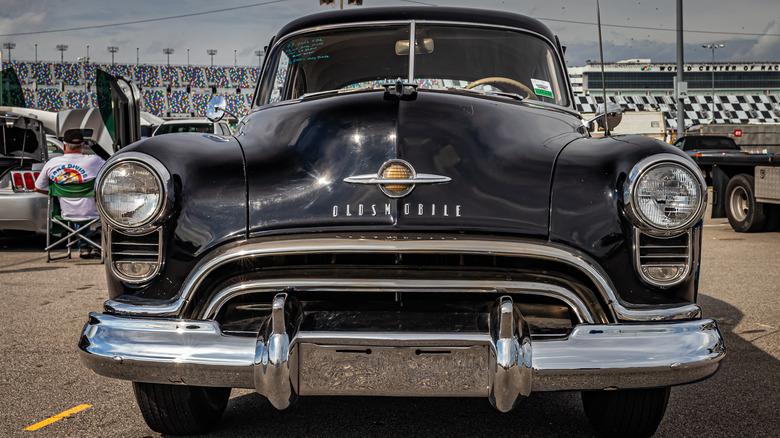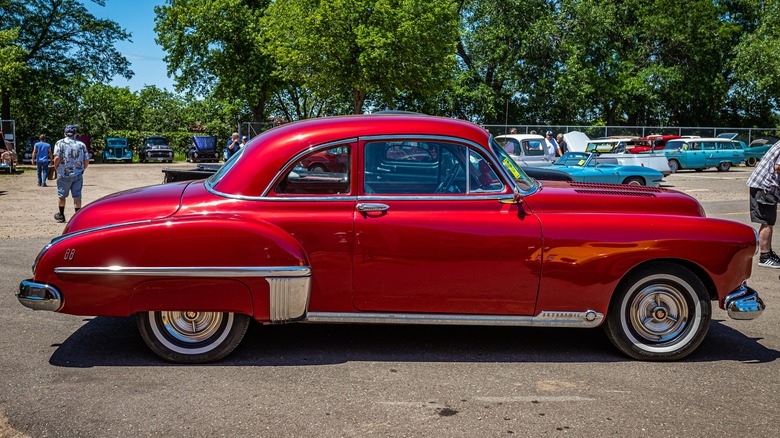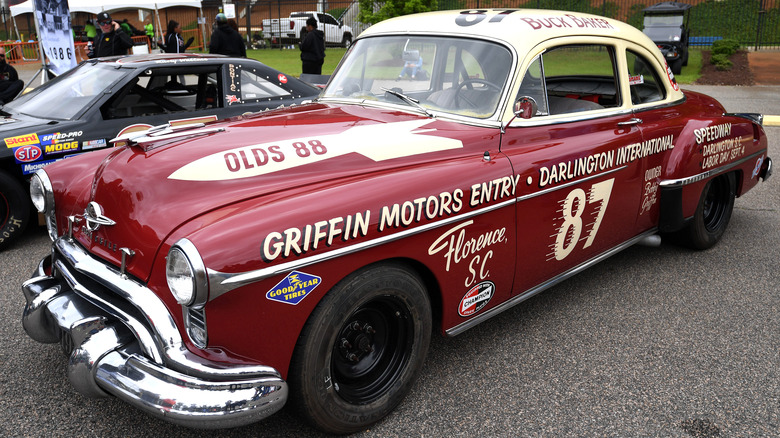Why Some Car Experts Believe The Oldmobile 88 Is One Of The First Muscle Cars Ever Made
Many people point to the 1964 Pontiac GTO as the first muscle car. That's understandable enough, given how impactful the Muscle Car Wars were back in the heady days of the early 60s. That was a golden era when all the big U.S. automakers were duking it out to make the biggest, stockiest (one might say) engines packing the most potent ponies that could fit under a hood.
Then, the OPEC Oil Crisis reared its global head in 1973 and slammed the brakes on the gas-guzzling muscle cars.
But memory is fickle and fades over time. Northwestern Medicine likens memory to the telephone game where every time you remember something from the past, your brain will actually change the details, so the next time you recall that thing, it'll be from the last time you did so and not the original event itself at all. So what was the first muscle car? They're generally considered beefy American-made coupes with high-octane engines built for high-performance driving. Others add that if a vehicle was marketed using metrics like speed, track, and elapsed times, then Chrysler did just that in 1955 with its C-300, and thus it is a viable candidate for the "first."
But as a wizened old Jedi Master once said (voiced by the incomparable Frank Oz), "There is another."
A mid-range Olds with a rocket under the hood
It's ironic then that Oldsmobile was at the forefront of the '60s American Muscle movement because they're also the company that dropped what many consider to be the actual first "muscle car" as it has come to be defined. To get there, though, we must hop into the time-jumping DeLorean and go back another six years to 1949, when Olds rolled out its "Rocket" 88.
If you're a NASCAR fan, you know it began holding races in 1948, but that inaugural race used pre-World War II cars in a Modified Division. The following year (1949) was the first year it held the Strictly Stock Division (now known as the Cup Series) to showcase new model unmodified automobiles. Keep that tidbit tucked away for now.
Oldsmobile wasn't the only automaker building overhead V8 engines in '49, but the one offered by Cadillac was vastly different. Also, where Cadillac motors were used in more luxurious GM models, Olds motors were used in — go figure — Oldsmobile cars.
Strictly speaking, the Rocket 88 was a full-size car, but it was marketed as a mid-range model that would fit between the entry 76 and the top-of-the-line 98. Oldsmobile literally took bits and pieces from both to make the Rocket 88. It was wrapped in an Oldsmobile 76 body (shorter and lighter than the 98) but used the same powerful V8 found in the 98, giving it the best of both worlds and the best power-to-weight ratio in its entire lineup.
NASCAR, moonshine, and Rock & Roll
This was a fact that did not go unnoticed by the moonshiners and bootleggers, which, despite being years removed from Prohibition (1920 – 1933), was still illegal to transport liquor in the South. According to accounts, the 88 was not only faster than virtually everything else on the road at the time, but it also had enormous trunk space capable of carrying an abundance of the illegal elixir.
Many of NASCAR's early stars weren't just drivers but owned and built cars explicitly for running moonshine. To this end, the Olds 88 featured a 303 cubic-inch (5.0-liter) mill-delivered 135 hp Rocket 88 engine, one of the first modern high-compression overhead valve V8s.
While that might not sound like a lot of horsepower by today's standards, it won five of the eight races during that first 1949 NASCAR season of unmodified cars. Not impressive enough for you? The following year (1950), the 88s won 10 of 19 races, and Oldsmobile took home NASCAR's first Manufacturers' Championship.
And since we're keeping track of firsts, the full-size mid-range Olds also inspired what many consider the first rock and roll song (in 1951), appropriately titled "Rocket 88" by Ike Turner and the Kings of Rhythm. Rock and roll and muscle cars is a paradigm-shifting match made in America.


